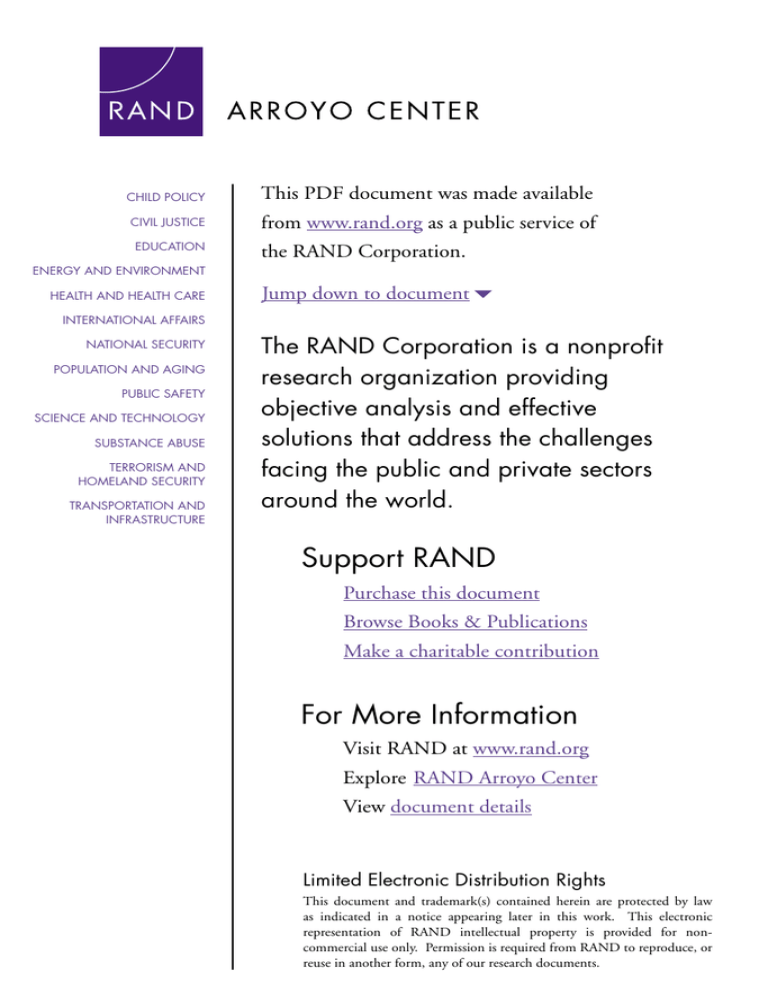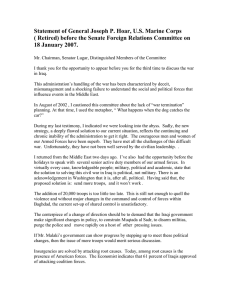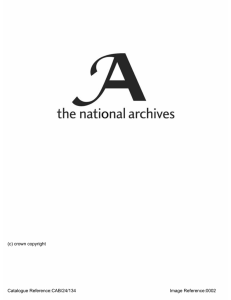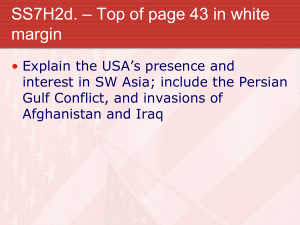6 The RAND Corporation is a nonprofit om
advertisement

CHILD POLICY This PDF document was made available CIVIL JUSTICE from www.rand.org as a public service of EDUCATION the RAND Corporation. ENERGY AND ENVIRONMENT HEALTH AND HEALTH CARE Jump down to document6 INTERNATIONAL AFFAIRS NATIONAL SECURITY POPULATION AND AGING PUBLIC SAFETY SCIENCE AND TECHNOLOGY SUBSTANCE ABUSE TERRORISM AND HOMELAND SECURITY TRANSPORTATION AND INFRASTRUCTURE The RAND Corporation is a nonprofit research organization providing objective analysis and effective solutions that address the challenges facing the public and private sectors around the world. Support RAND Purchase this document Browse Books & Publications Make a charitable contribution For More Information Visit RAND at www.rand.org Explore RAND Arroyo Center View document details Limited Electronic Distribution Rights This document and trademark(s) contained herein are protected by law as indicated in a notice appearing later in this work. This electronic representation of RAND intellectual property is provided for noncommercial use only. Permission is required from RAND to reproduce, or reuse in another form, any of our research documents. This product is part of the RAND Corporation monograph series. RAND monographs present major research findings that address the challenges facing the public and private sectors. All RAND monographs undergo rigorous peer review to ensure high standards for research quality and objectivity. American Public Support for U.S. Military Operations from Mogadishu to Baghdad Eric V. Larson Bogdan Savych Prepared for the Arroyo Center Approved for public release; distribution unlimited The research described in this report was sponsored by the United States Army under Contract No. DASW01-01-C-0003. Library of Congress Cataloging-in-Publication Data Larson, Eric, 1957– American public support for U.S. military operations from Mogadishu to Baghdad / Eric Larson, Bogdan Savych. p. cm. Includes bibliographical references. “MG-231.” ISBN 0-8330-3672-6 (pbk.) 1. United States—Foreign relations—1989—Public opinion. 2. United States— Military policy—Public opinion. 3. Intervention (International law)—Public opinion. 4. War—Public opinion. 5. Public opinion—United States. 6. United States—History, Military. I. Savych, Bogdan. II. Title. E885.L368 2004 355.4'773—dc22 2004016643 The RAND Corporation is a nonprofit research organization providing objective analysis and effective solutions that address the challenges facing the public and private sectors around the world. RAND’s publications do not necessarily reflect the opinions of its research clients and sponsors. R® is a registered trademark. © Copyright 2005 RAND Corporation All rights reserved. No part of this book may be reproduced in any form by any electronic or mechanical means (including photocopying, recording, or information storage and retrieval) without permission in writing from RAND. Published 2005 by the RAND Corporation 1776 Main Street, P.O. Box 2138, Santa Monica, CA 90407-2138 1200 South Hayes Street, Arlington, VA 22202-5050 201 North Craig Street, Suite 202, Pittsburgh, PA 15213-1516 RAND URL: http://www.rand.org/ To order RAND documents or to obtain additional information, contact Distribution Services: Telephone: (310) 451-7002; Fax: (310) 451-6915; Email: order@rand.org Summary While it is not at all clear that public opinion is a dominant factor in decisions on whether or not to undertake military operations, there is ample evidence that the public opinion environment shapes the way military operations are justified and even, in some cases, the way they are conducted. And, as shown in the Vietnam War, Lebanon, and Somalia, presidents can find that an unfavorable public opinion environment ultimately constrains the range of politically acceptable policies for successfully concluding a military operation. This report describes American public opinion toward military operations from the final stage of the Somalia intervention through the global war on terrorism (GWOT), and it identifies the key factors that are associated with—and can be used to predict—support or opposition for military operations conducted under the umbrella of the GWOT. The study builds upon the insights of an earlier RAND study that identified the factors associated with support or opposition—and the willingness to tolerate casualties—in a wide range of military operations, including World War II, the Korean War, the Vietnam War, the first Gulf War, and the U.S. interventions in Panama and Somalia (Larson, 1996a). Based upon our analyses of the available public opinion data, including bivariate and multivariate analyses of individual-level data from polling datasets, the most important predictors of support or opposition for military actions in the peace operations of the 1990s—and the GWOT as well—are a small set of key beliefs that are linked to support or opposition in a very sensible fashion: xvii xviii American Public Support for U.S. Military Operations • Importance of the stakes. Beliefs about the importance of the United States’ stakes in a situation are systematically associated with support and opposition for military operations there: those who believe the United States has important stakes—whether in terms of vital national interests, security interests, or moral or humanitarian interests—are more likely to support the operation than those who don’t believe the United States has important stakes involved. • Prospects for success. Beliefs about the prospects for a successful outcome in the operation are also systematically associated with support or opposition: those who are more confident in a successful outcome are more likely to support the operation than those who are less confident. • Expected and actual casualties and other costs. Beliefs about the likely costs, especially in casualties, are also associated with support: those who expect few casualties typically are more likely to support the operation than those who expect many casualties. • Partisan leadership and “followership.” These beliefs, and support and opposition as well, are in turn related to partisan leadership and what we call “followership”—the inclination to follow one’s “natural” party or ideological leaders: individuals who are members of the president’s party are more likely to support a president’s use of force than those who are not, and within each party, those who are the best informed are more likely to take the same positions as their partisan leaders than those who are less well informed. Using respondent-level datasets from polls done on various operations (Haiti, Bosnia, Kosovo, Operation Enduring Freedom in Afghanistan, and Operation Iraqi Freedom), our bivariate analyses consistently demonstrated a statistically significant relationship between support and these variables, and between key beliefs about the military operation and membership in the president’s party. And, using a family of statistical techniques called probit regression, we were able to correctly predict support or opposition for about 60 to 85 percent of the respondents based upon these key variables. Summary xix Our multivariate analyses suggested that the perceived importance of the stakes was the most important belief predicting support for the operation. We also were able to develop a cogent and empirically supported explanation for another phenomenon: when support is lost, those who oppose an operation may do so either because they want to cut their losses and withdraw or because they believe that greater effort is warranted. Beliefs about the importance of the stakes and prospects for success also predict individuals’ positions on the matter: those who believe that the stakes are important and the prospects favorable are more likely to support escalation, while those holding the opposite beliefs tend to prefer withdrawal. Our modeling of respondentlevel public opinion data on Somalia after the October firefight correctly predicted the preferences for escalation and withdrawal of over 60 percent of the respondents. By comparison, continued support for the U.S. intervention in Iraq after the early November deaths in the shoot down of a CH-46 Chinook helicopter was, because of the perception of greater stakes in Iraq, far more stalwart. The robustness of this simple model—whether in terms of its ability to predict outcomes during specific military operations, its ability to predict outcomes in datasets based upon models estimated using other datasets, its reliability over time and across cases, and its ability to explain multiple phenomena—allowed us to analyze and diagnose the public opinion on GWOT-related military operations by concentrating on a small set of conceptually meaningful variables. The Peace Operations of the 1990s To establish the robustness of our model for analyzing the public opinion on the GWOT, we first assessed a number of peace operations from the 1990s: the U.S. peace operations in Somalia, Haiti, Bosnia, and Kosovo. xx American Public Support for U.S. Military Operations Somalia Newly available data from a poll done by ABC News just before the October 3–4, 1993 firefight in Mogadishu showed that Americans preferred pulling out of Somalia by a nearly two-to-one margin even before the firefight, and following the firefight, this sentiment increased. A review of all of the available public opinion data on withdrawal and escalation sentiment confirmed that this result was a robust one: the overwhelming preference of Americans following the firefight was an orderly withdrawal from Somalia, i.e., a withdrawal following the recovery of U.S. servicemen held hostage. Our statistical models correctly predicted escalation or withdrawal preferences for slightly more than 60 percent of the respondents, and suggested that the reason that most preferred withdrawal was the widespread belief that the United States had only modest stakes in the situation. By comparison, the deaths of 16 U.S. service personnel in Iraq in early November 2003 led to a very different response: majority support for the U.S. mission in Iraq held, and there was even evidence of a stiffening in resolve. The reason for the difference was the more prevalent belief that the United States had important stakes in Iraq. As a result of these analyses, we conclude that the frequently heard academic arguments that most Americans preferred an increased commitment in Somalia, or that President Clinton could have drawn upon a deep well of support for continuing the operation there, are on exceedingly dubious empirical ground. Our analyses also suggest that the argument that members of the public are more “defeat-phobic” than “casualty-phobic” is not true in cases where the United States’ stakes are judged to be relatively unimportant; none of the peace operations of the 1990s (Somalia, Haiti, Bosnia, Kosovo) were judged particularly important by most members of the public, and avoidance of casualties turned out to be a more important consideration than avoidance of defeat in these cases. Haiti, Bosnia, and Kosovo In Haiti, Bosnia, and Kosovo, only about four in ten typically supported the use of U.S. ground troops in a combat role, and in Haiti and Bosnia, fewer than half typically supported the use of U.S. troops Summary xxi at all. In the case of Kosovo, there was typically majority support for the air campaign as well as the use of U.S. troops as peacekeepers once peace had actually been established, but most opposed the use of ground troops in a combat role. The main reason for this reluctance to commit ground troops was that few believed the stakes were sufficiently important to risk the lives of U.S. servicemen: • Only about three in ten of those polled before the intervention in Haiti typically believed that the United States had vital interests involved, or found very convincing the argument that the United States should contribute troops to a UN intervention for moral reasons. • Only about three in ten of those polled before the operation in Bosnia felt that the United States had a moral obligation to intervene there, and fewer than four in ten Americans believed that Bosnia engendered particularly important U.S. interests. • While 60–70 percent typically said that the United States had a moral obligation in Kosovo, fewer than half thought the United States had vital interests there. More than half supported an air war, while about four in ten supported the use of combat troops. This low level of support for using ground troops in combat in peace operations involving only modest U.S. stakes was also evident in the public opinion data on Lebanon and, more recently, Liberia. Focusing on the key beliefs described above, and on such individual-level characteristics as party, gender, and race, our statistical modeling correctly predicted support for 75 percent of the respondents in polling on Haiti, over 80 percent in polling on Bosnia, and 66–73 percent in polling on Kosovo. The modeling also consistently suggested that the perceived importance of the stakes was the most important belief in determining support or opposition. These results suggested that our basic conceptual model of support, developed using an earlier set of cases, was quite robust and would also be suitable for use in understanding the sources of and fault lines in support for military operations undertaken under the umbrella of the war on terrorism. xxii American Public Support for U.S. Military Operations Attitudes Toward the Global War on Terrorism Our analysis of the public opinion data on military operations undertaken in the war on terrorism shows that there has been much higher support—and a higher willingness to use ground troops and even accept casualties—in actions related to the GWOT than was observed in the peace operations of the 1990s that preceded it. The principal reason is the post–September 11 view that most Americans believed this new war to involve nearly existential stakes. Americans polled after 9/11 who were asked which event was the more historically significant—the attacks on the World Trade Center and Pentagon or the attack on Pearl Harbor—chose 9/11 by a nearly three-to-one margin. The 9/11 attacks also resonated with longstanding fears about the threat of terrorism and weapons of mass destruction, each of which had been identified by eight in ten or more Americans for a number of years as critically important threats that needed to be addressed. The result has been high support for the use of ground troops in spite of the strong possibility of high casualties, and in spite of beliefs that the GWOT is likely to be a long, difficult war. And although most Americans continue to believe that the GWOT will involve additional military actions, they nevertheless continue to support the war, especially as it relates to capturing or killing Osama bin Laden and eliminating the Al Qaeda organization. Indeed, since about September 2002, six in ten have said that bin Laden must be killed or captured for the GWOT to be considered a success. Operation Enduring Freedom in Afghanistan The average level of support for the U.S. military action in Afghanistan approached the eight in ten that typically supported World War II. Using the key predictors described above, our statistical modeling predicted support or opposition for 79–86 percent of the respondents in datasets from three separate polls. As suggested by the discussion of the GWOT above, the principal predictors of support were the perceived importance of the stakes and prospects for success; be- Summary xxiii liefs about casualties, and membership in the president’s party, were also statistically significant but less important predictors. Polling organizations have not polled very heavily on Afghanistan since the rout of the Taliban and Al Qaeda in late 2001 and early 2002, but the last available data suggested that majority support for the U.S. military effort in Afghanistan was holding up. Although confidence in the war on terrorism was buoyed by the victory in Iraq, the public appears to be having a difficult time judging progress, in large measure due to the failure to capture or kill bin Laden and the inability to judge the importance of various arrests and military engagements in continued action in Afghanistan. Operation Iraqi Freedom Public support for the war in Iraq was also high by historical standards, but not quite as high as support for Afghanistan or the first Gulf War. Support and opposition on Iraq were most influenced by beliefs about the importance of the United States’ security interests, but also by the perceived prospects for success, likely casualties, and membership in the president’s party; based upon these factors, our statistical models were able to predict support or opposition for about 75 percent of the respondents in the two poll datasets we analyzed. In spite of widespread predictions that Americans would not support the war without UN authorization, the fact that seven in ten ultimately would support the war should not have been terribly surprising in light of the public opinion record since the first Gulf War. This record showed that in the more than 100 times the question was asked, the percentage of Americans supporting reintroduction of U.S. ground troops in an effort to overthrow Saddam Hussein never fell below a majority. The prevalence of beliefs about the importance of the stakes and, to a lesser extent, the high probability of success were the key sources that buoyed support; as a result, although casualty expectations were much higher than in the peace operations we examined, the willingness to tolerate casualties in a war in Iraq also was much higher. While there is some evidence that majorities of the public continue to view the success of postconflict stability, “nation building,” xxiv American Public Support for U.S. Military Operations and democracy building operations in Iraq as very important, there are some worrisome trends in postwar attitudes on Iraq. While some measures of support for U.S. action in Iraq have held up reasonably well (e.g., six in ten continue to say the war was the right thing to do), others have not. There has also been a deterioration among the numbers who feel the war in Iraq was worth its costs, in spite of Saddam Hussein’s capture, in part because of the failure to find weapons of mass destruction. That said, the October 2003 passage of United Nations Security Council Resolution 1511, which provided political cover for other nations to provide troops, and financial contributions made at an international donors conference offered the prospect of buoying support for the war in Iraq. If the United States were still to discover weapons of mass destruction or credible evidence of connections between Iraq and Al Qaeda, or if there was a reduction or cessation of attacks or more visible evidence that Iraq is moving toward stability and a viable democracy, those developments would also be expected to buoy support. Our analyses suggest that the main fault lines on Iraq are largely partisan in nature. Democratic critics of the administration’s Iraq policy have sought, first, to suggest that other problems (Al Qaeda or North Korea) were in fact more important than Iraq, and then to question the administration’s credibility on the justification for war (first weapons of mass destruction, then Iraqi connections to Al Qaeda). Recent administration speeches on Iraq appear to have done little to staunch the erosion in support for Iraq, and the presidential campaign has only sharpened these divisions, which will in turn only weaken overall support for operations in Iraq. Another fault line is that the willingness of Americans to support military operations, including using ground troops and accepting casualties, rests on beliefs that the stakes remain high and, to a lesser extent, that progress is being made: if most Americans were to come to believe that the stakes in Iraq were no more important than those in the peace operations of the 1990s, for example, or that the situation closely resembled the quagmires of Vietnam, Lebanon, and Somalia, remaining support and the willingness to accept casualties Summary xxv could quickly erode. The public’s reaction to the 16 deaths incurred in the helicopter shoot down in Iraq in early November 2003 and the deaths of four civilians in April 2004 provide evidence that the greater robustness of support for operations in Iraq than in Somalia is mainly attributable to the greater importance Americans have attached to Iraq. It also is worth pointing out, however, that the characteristics of the sort of war we are waging in the GWOT—mostly in the shadows, with only occasional evidence of success—make it a significant challenge to sustain public optimism about the outcome. Implications We now turn to the main implications of this research for the Army and national political leaders. The main implication for the Army is that Americans have proved themselves far more willing to use ground troops—to put “boots on the ground”—and to accept casualties in operations conducted under the GWOT than in any of the military operations in the decade that preceded it. This suggests more support for an Army role than was observed in the peace operations of the 1990s, at least to the extent that the specific military operations that are proposed under the GWOT are judged to be relevant to the GWOT, and that they have good prospects for a successful outcome. To the extent that the public believes that proposed new military operations are part of the GWOT, national leaders should expect a relatively permissive public opinion environment for taking military action, including the use of ground forces. It seems likely, however, in light of questions that have arisen about the existence and nature of any connections between Iraq and Al Qaeda, that it is no longer a foregone conclusion that Americans will unquestioningly accept arguments making these connections. More broadly, the immediate aftermath of 9/11 initially seemed to show that a post–Cold War consensus on the focus of national security and defense policies had finally emerged among national leaders in the executive and legislative branches: for the foreseeable future, xxvi American Public Support for U.S. Military Operations it seemed at the time, leaders in both parties supported a focus for U.S. national security on terrorist groups with global reach, their sponsors, and those providing them refuge. The U.S. action in Afghanistan generally received overwhelming bipartisan support from national leaders, and public support accordingly was preternaturally high. Bipartisan support for the war in Iraq was slightly weaker, and as a result, public support, while still high, was somewhat lower than that observed for Afghanistan. Bipartisan consensus on postconflict stability operations in Iraq, however, now appears elusive at best. It is still too early to say whether or how this breakdown in consensus might color support for other military actions taken under the banner of the GWOT. Nevertheless, it raises the specter that, as a result of the reappearance of leadership divisions, future operations in the GWOT also may suffer from lower and/or more highly conditional support. While national leaders argue their differences on national security, they need to remain mindful that a failure to agree on the ends, ways, and means for ensuring the nation’s security in the face of these new threats can actually weaken the credibility of deterrence and coercive diplomacy—and beliefs in the United States’ ability to stay the course in its war on terrorism—and ultimately encourage the nation’s enemies. The United States has always been a noisy democracy when it comes to issues of war and peace—witness the partisan divisions over the peace operations of the 1990s. Unlike these earlier operations, however, where the U.S. stakes were relatively modest, and the consequences of failure equally so, the outcome of the GWOT greatly matters. The only way to sustain the public’s support for this war—arguably a requirement for its success—will be for national leaders to forge policies that reflect a new consensus on the matter. Absent such a consensus, the nation’s ability to reduce this grave threat may be placed in jeopardy.




